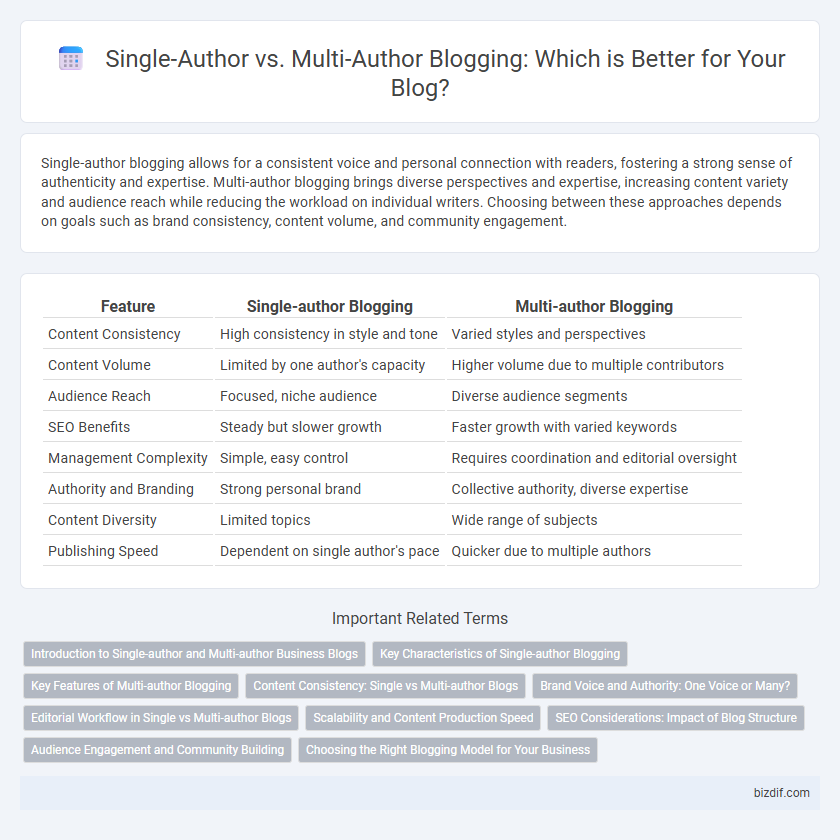Single-author blogging allows for a consistent voice and personal connection with readers, fostering a strong sense of authenticity and expertise. Multi-author blogging brings diverse perspectives and expertise, increasing content variety and audience reach while reducing the workload on individual writers. Choosing between these approaches depends on goals such as brand consistency, content volume, and community engagement.
Table of Comparison
| Feature | Single-author Blogging | Multi-author Blogging |
|---|---|---|
| Content Consistency | High consistency in style and tone | Varied styles and perspectives |
| Content Volume | Limited by one author's capacity | Higher volume due to multiple contributors |
| Audience Reach | Focused, niche audience | Diverse audience segments |
| SEO Benefits | Steady but slower growth | Faster growth with varied keywords |
| Management Complexity | Simple, easy control | Requires coordination and editorial oversight |
| Authority and Branding | Strong personal brand | Collective authority, diverse expertise |
| Content Diversity | Limited topics | Wide range of subjects |
| Publishing Speed | Dependent on single author's pace | Quicker due to multiple authors |
Introduction to Single-author and Multi-author Business Blogs
Single-author business blogs offer consistent voice and perspective, enabling a strong personal brand and direct connection with the audience. Multi-author business blogs bring diverse expertise and varied content, enhancing topic coverage and audience engagement. Choosing between single-author and multi-author blogging depends on goals such as brand identity, content volume, and resource availability.
Key Characteristics of Single-author Blogging
Single-author blogging emphasizes a unified voice and consistent tone, allowing for a personal connection with readers and a clear, focused brand identity. This approach facilitates streamlined content planning and faster decision-making without the need for extensive coordination or editorial approval. Moreover, the author maintains complete creative control, ensuring all posts align closely with their expertise and style, which often results in higher authenticity and reader trust.
Key Features of Multi-author Blogging
Multi-author blogging platforms enable diverse perspectives and expertise, enriching content quality and audience engagement. These blogs typically feature collaborative editorial workflows, role-based access controls, and seamless content management systems to coordinate multiple contributors efficiently. Enhanced SEO benefits arise from varied keywords and increased posting frequency, driving higher traffic and broader reach.
Content Consistency: Single vs Multi-author Blogs
Single-author blogs typically maintain a consistent voice and tone, strengthening the brand identity and fostering a loyal audience through uniform content style. Multi-author blogs offer diverse perspectives and expertise, enriching content variety but potentially causing fluctuations in style and quality that challenge reader expectations. Effective editorial guidelines and communication are crucial for multi-author blogs to balance diversity with content consistency in blogging.
Brand Voice and Authority: One Voice or Many?
Single-author blogging fosters a consistent brand voice that strengthens authority by reflecting a singular perspective and style, enhancing audience trust and loyalty. Multi-author blogging introduces diverse viewpoints and expertise, enriching content variety and broadening audience reach while potentially challenging voice consistency. Balancing uniform editorial guidelines with diverse contributions ensures a cohesive brand identity and authoritative presence across multiple authors.
Editorial Workflow in Single vs Multi-author Blogs
Single-author blogging streamlines the editorial workflow by centralizing content creation, editing, and publishing responsibilities to one individual, reducing the need for extensive coordination and communication. Multi-author blogs require robust editorial workflows involving content calendars, guidelines, and collaboration tools to manage multiple contributors, maintain consistent quality, and ensure timely publication. Effective editorial management in multi-author setups improves content diversity and frequency but demands more structured processes and oversight.
Scalability and Content Production Speed
Single-author blogging limits scalability due to the reliance on one individual for content creation, often resulting in slower publishing frequency and reduced topic diversity. Multi-author blogging significantly enhances content production speed by distributing workload among multiple contributors, enabling faster publishing schedules and a broader range of perspectives. This collaborative approach supports scalability by increasing output volume, improving audience engagement, and allowing the blog to cover more varied subjects efficiently.
SEO Considerations: Impact of Blog Structure
Single-author blogging often benefits from a consistent voice, which can strengthen keyword relevance and topical authority, enhancing SEO performance. Multi-author blogging introduces diverse content and varied keyword targets, boosting site breadth but requiring careful management of internal linking and URL structure to maintain SEO coherence. Organizing tags, categories, and author archives strategically is crucial to optimize crawlability and search engine indexing for both blog formats.
Audience Engagement and Community Building
Single-author blogging fosters a consistent voice and personal connection, which enhances audience trust and loyalty, leading to deeper engagement levels. Multi-author blogging introduces diverse perspectives and varied content, attracting a broader audience and encouraging community interaction through shared ideas. Combining consistent quality with varied viewpoints strengthens community building and sustains long-term audience growth.
Choosing the Right Blogging Model for Your Business
Single-author blogging offers consistency in voice and a personal connection with the audience, ideal for businesses emphasizing brand identity and expertise. Multi-author blogging drives diverse perspectives, increased content output, and broader topic coverage, making it suitable for companies seeking rapid growth and varied expertise. Evaluating business goals, available resources, and target audience engagement helps determine the optimal blogging model to maximize content effectiveness and SEO performance.
Single-author Blogging vs Multi-author Blogging Infographic

 bizdif.com
bizdif.com